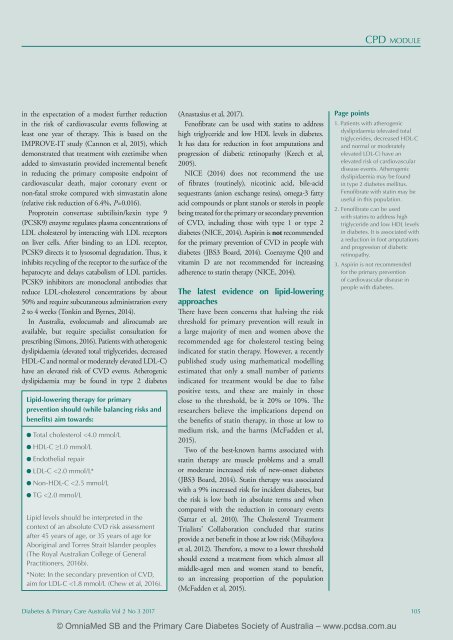DPCA 2-3_100-110_wm
Create successful ePaper yourself
Turn your PDF publications into a flip-book with our unique Google optimized e-Paper software.
CPD module<br />
in the expectation of a modest further reduction<br />
in the risk of cardiovascular events following at<br />
least one year of therapy. This is based on the<br />
IMPROVE-IT study (Cannon et al, 2015), which<br />
demonstrated that treatment with ezetimibe when<br />
added to simvastatin provided incremental benefit<br />
in reducing the primary composite endpoint of<br />
cardiovascular death, major coronary event or<br />
non-fatal stroke compared with simvastatin alone<br />
(relative risk reduction of 6.4%, P=0.016).<br />
Proprotein convertase subtilisin/kexin type 9<br />
(PCSK9) enzyme regulates plasma concentrations of<br />
LDL cholesterol by interacting with LDL receptors<br />
on liver cells. After binding to an LDL receptor,<br />
PCSK9 directs it to lysosomal degradation. Thus, it<br />
inhibits recycling of the receptor to the surface of the<br />
hepatocyte and delays catabolism of LDL particles.<br />
PCSK9 inhibitors are monoclonal antibodies that<br />
reduce LDL-cholesterol concentrations by about<br />
50% and require subcutaneous administration every<br />
2 to 4 weeks (Tonkin and Byrnes, 2014).<br />
In Australia, evolocumab and alirocumab are<br />
available, but require specialist consultation for<br />
prescribing (Simons, 2016). Patients with atherogenic<br />
dyslipidaemia (elevated total triglycerides, decreased<br />
HDL-C and normal or moderately elevated LDL-C)<br />
have an elevated risk of CVD events. Atherogenic<br />
dyslipidaemia may be found in type 2 diabetes<br />
Lipid-lowering therapy for primary<br />
prevention should (while balancing risks and<br />
benefits) aim towards:<br />
l Total cholesterol
















